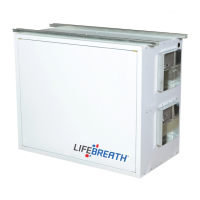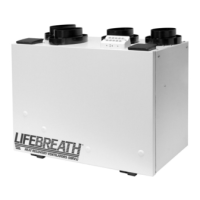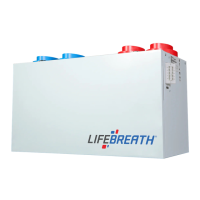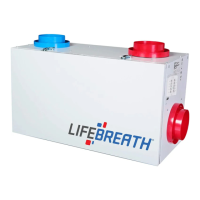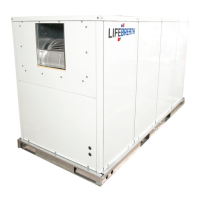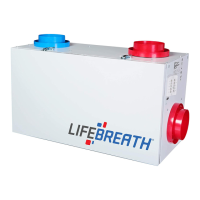Do you have a question about the Lifebreath ERV series and is the answer not in the manual?
Guidelines for selecting an appropriate installation location for the ERV unit.
Key notes, attention points, cautions, and warnings for pre-installation.
Details the recommended installation of a spring-loaded backdraft damper.
Covers critical considerations for simplified installation, including codes and applications.
Details the recommended installation of a spring-loaded backdraft damper.
Covers critical considerations for partially dedicated systems, including codes and applications.
Details the recommended installation of a spring-loaded backdraft damper.
Covers critical considerations for fully dedicated systems, including codes and applications.
Instructions for mounting the 30ERV model using mounting tabs and S-hooks.
Guidance on mounting the 120ERV/120ERV-RX using L-brackets.
Detailed steps for attaching and securing the unit using hanging straps.
Information on using adjustable grilles for balancing room airflows.
Details on the kitchen grille with a removable grease filter.
Description of the round, adjustable TechGrille for quiet air distribution.
Rough-in fitting for drywall installation, available in 6-inch size.
Fitting for running ducting through studded walls, available in 4 and 6-inch sizes.
Rough-in fitting for drywall, adapts to ducting, available in 4, 5, 6-inch sizes.
Fitting for ceiling tiles or finished drywall, with retaining ring.
Warning about exhaust grille placement relative to stoves to prevent grease entry.
Notes on installing weatherhoods, sealing ducts, and duct length.
Guidelines for proper placement of intake and exhaust weatherhoods.
Advice to verify compliance with local building codes for Dual Hood installation.
Details on the 99-190 Dual Hood requiring one exterior wall hole.
Cautions regarding sealant application and duct insulation for the Dual Hood.
Instructions for surface or flush mounting the digital and ventilation controls.
Details on connecting the control to the ERV unit.
Explanation of different operation modes like Continuous Ventilation and timed cycles.
Description of recirculation modes and their applicability with forced air systems.
Important warnings regarding power disconnect and electrical shock prevention.
Steps for pairing the wireless timer with the main wall control.
Instructions on how to unpair the wireless timer from the control.
Guidance on installing the wireless timer unit.
Steps to pair the RX02 repeater with the main wall control.
Notes on repeater placement and understanding status indicator lights.
Ensuring the ERV operates with the furnace blower.
Setting the ERV to 'standby-off' instead of 'fully-off'.
Adjusting DIP switches for different high-speed airflow settings (Hi1, Hi2, Hi3).
Cautions regarding competing airflows and building code compliance for 'standby-off'.
How to activate timer cycles and set the unit to lockout mode.
Instructions for installing plugs in the bottom tray of specific ERV models.
Diagrams showing front and top dimensions and port configurations.
Recommended front and bottom clearances for servicing the unit.
Diagrams showing bottom and side dimensions and port configurations.
Diagrams showing front and top dimensions and port configurations.
Diagrams showing top and front dimensions and port configurations.
Explains why balancing airflows is critical for unit performance.
Details on using a digital manometer and pitot tube for airflow measurement.
Warnings about positive and negative pressure effects on building structures.
Example calculation of Cubic Feet per Minute (CFM) from velocity pressure.
Installation instructions for balancing collars and dampers in ductwork.
Note on potential need for dampening due to high static pressures in furnace returns.
Steps to take before performing the air balancing procedure.
Detailed procedure for measuring and balancing airflow using a pitot tube.
Causes and solutions for poor airflows and cold supply air.
Troubleshooting high or low humidity levels and condensation.
Addressing ERV frosting, duct condensation, and excessive vibration.
| Type | Energy Recovery Ventilator (ERV) |
|---|---|
| Application | Residential |
| Core Technology | Heat and moisture recovery core |
| Airflow | Varies by model |
| Voltage | 120V |
| Mounting | Wall or ceiling |
| Duct Connection | 4, 6, or 8 inches (depending on model) |
| Filter Type | MERV filter |
| Controls | Built-in or optional wall-mounted control |
| Airflow Capacity | Varies by model (e.g., 50-200 CFM) |
| Power Consumption | Varies by model |
| Noise Level | Varies by model |
| Dimensions | Varies by model |
| Weight | Varies by model |
